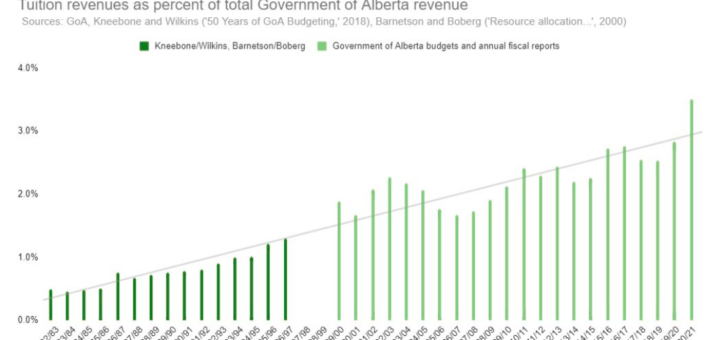What Alberta’s first pandemic-era fiscal update means for university students

Post-secondary tuition contributes unprecedented revenue to Alberta economy
By Noel Harper, News Editor
Albertans received an update on the province’s fiscal house last week, granting a glimpse into the impact of ongoing economic contraction and the COVID-19 pandemic.
Finance Minister Travis Toews delivered the first-quarter update in the legislature to the tune of a $24.2 billion deficit — the largest in the province’s history — and $11.5 billion less in revenue.
This revenue has shifted dramatically beyond what Alberta is used to — in particular, what or who is providing a greater share of provincial funds.
Post-secondary tuition is one changing factor of Alberta’s budget, with an increasing percentage of revenue coming from university costs over the last three fiscal years, according to data compiled by the Council of Alberta University Students (CAUS).
Post-secondary students are now providing more for the province than its primary industry. In total, university tuition will account for $1.35 billion of Alberta’s revenue for 2020-2021. In contrast, money earned from oil and gas comes to just $1.2 billion.
Revenue from corporate taxes and from Alberta Gaming, Liquor and Cannabis will also be greater than from oil and gas.
The 2020 Alberta budget resulted in a $114 million decrease in funding to post-secondary education compared to the government’s 2019 plans. This resulted in a seven per cent increase in domestic tuition being instated by Mount Royal University in February.
The increase is taking effect during the current semester, the majority of which will take place away from campus due to COVID-19.
“The relative burden on students [in Alberta] has more than quintupled – and that doesn’t even account for the 15% increase in tuition in the next two years,” a Twitter thread from CAUS read in part.
“Increasingly, post-secondary education plays a critical role in transforming Alberta’s economy and creating lasting solutions for society,” wrote MRU President Tim Rahilly and Chancellor Dawn Farrell in the Calgary Herald.
Overall, the budget was relying on a significantly more positive economic outlook in February, including a deficit of only $7.5 billion and the lack of a global pandemic.
Now, the province’s deficit has increased by nearly $17 billion, and COVID-19 forced an economic shutdown that still has not fully been resolved.
This does not mean that government spending across the post-secondary sector has come to a halt. Throughout July and August, the Alberta government announced a total of 12 infrastructure projects at post-secondary institutions throughout the province including the University of Alberta, Lethbridge College and NAIT.
These projects totaled a cost of $98 million as part of the province’s economic recovery plan. The largest share of capital from this plan — $1.5 billion — is going to the Keystone XL pipeline project.
The next financial update for Alberta will be heard in November, followed by the 2021 budget this February.




